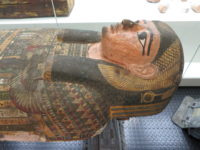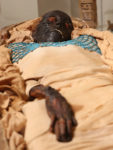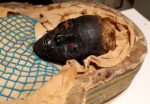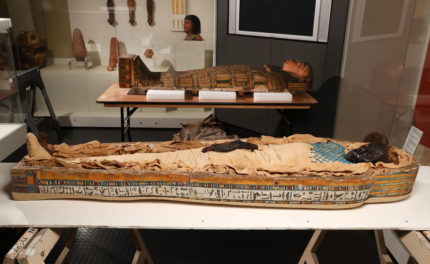 A new study of a famous mummy that has been the centerpiece of the Ulster Museum in Belfast since 1835 has revealed that she was murdered by being stabbed in the back.
A new study of a famous mummy that has been the centerpiece of the Ulster Museum in Belfast since 1835 has revealed that she was murdered by being stabbed in the back.
The mummy and her sarcophagus were acquired in Thebes in 1834 by Thomas Gregg, a wealthy lawyer and owner of Ballymenoch House in Holywood, today part of metro Belfast. Like many wealthy European tourists, Gregg sought out a human souvenir on the thriving Egyptian mummy market. The country was well-stocked with thousands of years worth of remains to dig up for the trade in mummies, a trade established in the Renaissance when mummy became an essential ingredient in any respectable pharmacopoeia. The market expanded geometrically in the early 19th century as the fashion for all things Egyptian exploded in the wake of the Napoleonic wars.
 Gregg had it shipped by boat to Belfast and donated it to the Belfast Natural History Society, now the Ulster Museum. On January 27th, 1835, the case was opened and the mummy unwrapped before a riveted audience. Mummy “unrollings” were a popular entertainment in the 19th century, and the inscribed case, fine linen wrappings and well-preserved remains complete with auburn curls generated much buzz in the media and among scholars at the time.
Gregg had it shipped by boat to Belfast and donated it to the Belfast Natural History Society, now the Ulster Museum. On January 27th, 1835, the case was opened and the mummy unwrapped before a riveted audience. Mummy “unrollings” were a popular entertainment in the 19th century, and the inscribed case, fine linen wrappings and well-preserved remains complete with auburn curls generated much buzz in the media and among scholars at the time.
The event was presided over by the Reverend Edward Hincks, who when not occupied by his clerical duties had dedicated his considerable intellectual prowess to learning and deciphering ancient languages, including Persian cuneiform, Akkadian cuneiform and Egyptian hieroglyphics. He translated the inscriptions on her coffin which revealed her to be Takabuti, a married woman between 20 and 30 years of age, who died around 600 B.C., the late 25th Dynasty. Her father was Nespare, priest of Amun, her mother Tasenirit.
 Takabuti has been a fixture of the museum’s Egypt gallery ever since and one of its most popular exhibits. The mummy has been extensively studied. In recent years she’s gotten new x-rays, CT scans, hair sample analysis and radiocarbon dating. The most recent study included DNA analysis and new, more detailed CT scans.
Takabuti has been a fixture of the museum’s Egypt gallery ever since and one of its most popular exhibits. The mummy has been extensively studied. In recent years she’s gotten new x-rays, CT scans, hair sample analysis and radiocarbon dating. The most recent study included DNA analysis and new, more detailed CT scans.
The scans show a clear stab wound in the upper back of her chest wall near her left shoulder that was the cause of death. Material seen in previous scans that had been thought to be her heart was in fact material the embalmers packed into the fatal wound. Her genetic haplotype, H4a1, has never been found before in Egyptians, modern or ancient.
The team, whose findings are made public on the 185 year anniversary of Takabuti’s unwrapping in 1835, also show that her DNA is more genetically similar to Europeans rather than modern Egyptian populations.
The team show Takabuti had an extra tooth – 33 instead of 32 – something which only occurs in 0.02% of the population and an extra vertebrae, which only occurs 2% of the population.
And Takabuti’s heart, previously thought to have been missing, was identified by the state of the art technology used by the researchers as intact and perfectly preserved.
